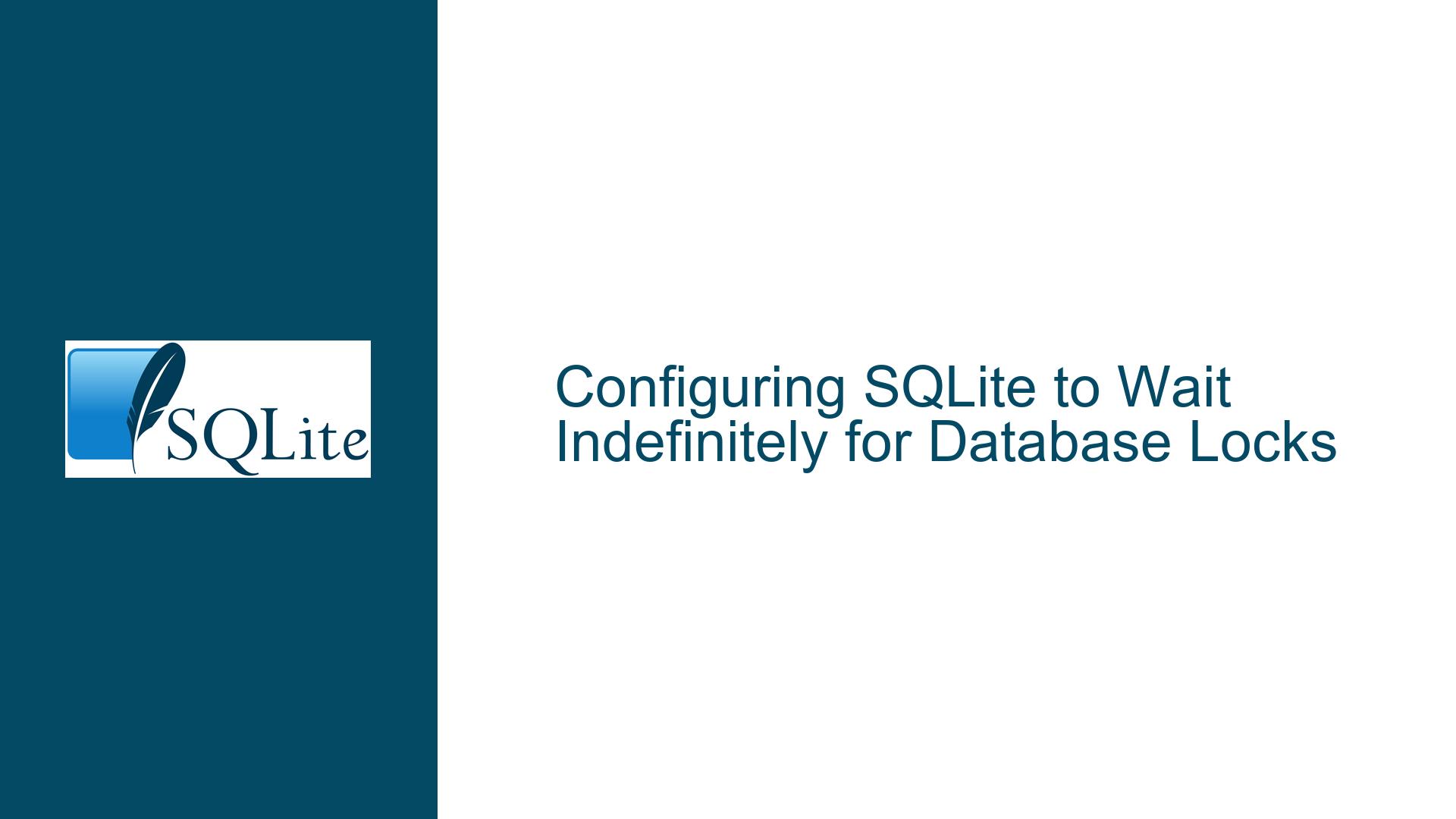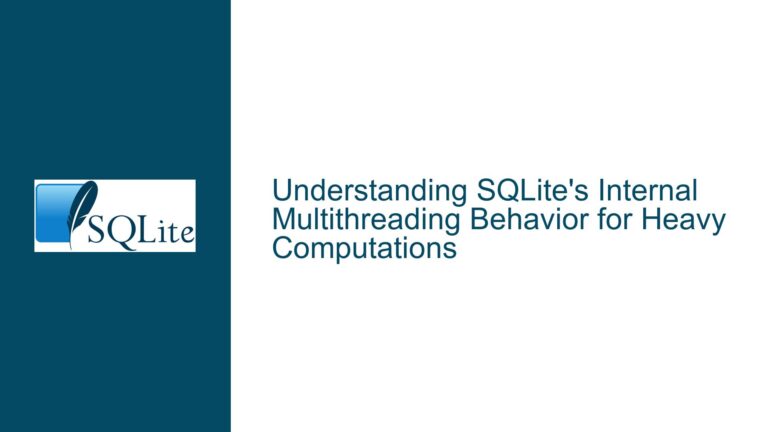Configuring SQLite to Wait Indefinitely for Database Locks
Understanding SQLite’s Busy Timeout Behavior and Infinite Lock Wait Scenarios
SQLite Lock Contention Management: Busy_Timeout Semantics and Practical Implementation Constraints
The core challenge revolves around configuring SQLite to wait indefinitely when encountering database lock contention. SQLite’s default behavior uses a busy timeout mechanism to manage concurrent access conflicts. Developers often seek to extend this timeout to mimic an infinite wait period for scenarios requiring guaranteed write access or long-running transactions. The fundamental issue lies in SQLite’s lack of a built-in "wait forever" parameter value for busy_timeout, requiring alternative approaches when maximum predefined timeout values prove semantically inadequate.
SQLite employs a file locking mechanism to coordinate concurrent database access across processes and threads. When a connection attempts to write to the database while another process holds an exclusive lock, SQLite triggers a "database is locked" error. The busy_timeout pragma specifies how long (in milliseconds) the database engine should retry the operation before returning this error. While setting busy_timeout to 2,147,483,647 milliseconds (INT32_MAX) achieves approximately 24.5 days of waiting time, this implementation detail lacks semantic clarity for developers seeking explicit infinite wait semantics.
The practical implications emerge in mission-critical systems requiring guaranteed write completion, such as financial transaction processors, real-time data logging systems, or distributed applications with strict consistency requirements. Developers often prefer code that explicitly communicates infinite wait intent through parameter names and values rather than relying on maximum integer fallbacks. This creates a documentation and maintenance challenge where the 24-day workaround requires explicit commentary to prevent future misinterpretation.
Three Primary Factors Limiting Infinite Lock Wait Configurations
1. SQLite API Design Philosophy for Lock Contention Resolution
SQLite’s architecture prioritizes deterministic behavior and process autonomy, deliberately avoiding truly infinite wait scenarios. The database engine delegates lock resolution responsibility to client applications through two mechanisms: the built-in busy timeout and custom busy handlers. This design prevents database connections from entering unrecoverable hanging states and maintains system-wide stability. The 24.5-day maximum timeout represents a compromise between practical usability and resource management, allowing developers to simulate long waits while preserving the ability to eventually report errors.
2. Language Binding Limitations in Busy Handler Customization
Many SQLite wrappers and language-specific implementations (including Python’s sqlite3 standard library module) expose only limited subsets of SQLite’s native capabilities. The Python interface provides access to the busy_timeout pragma through connection parameters but does not directly expose the underlying sqlite3_busy_handler C API. This abstraction layer prevents developers from implementing custom retry logic without modifying the interpreter’s native code or utilizing third-party extensions. Consequently, programmers using high-level language bindings must work within the constraints of timeout duration adjustments rather than implementing true infinite wait handlers.
3. Operating System and Filesystem Lock Behavior Uncertainties
Even with theoretically infinite wait implementations, lower-level system behaviors can interfere with lock resolution. Filesystem implementations may automatically release stale locks, network file systems might impose their own timeout restrictions, and operating systems could terminate processes exceeding resource limits. These environmental factors make genuine infinite wait configurations unreliable across different deployment environments. SQLite’s finite timeout approach provides consistent cross-platform behavior while allowing developers to implement application-specific lock recovery strategies.
Implementing Semantically Clear Infinite Wait Strategies in SQLite Environments
Step 1: Maximizing Built-in Busy Timeout with Intent Documentation
For environments using SQLite through language bindings without busy handler access, setting the maximum timeout value with explicit documentation remains the optimal approach:
import sqlite3
# Equivalent to 24.5 days - SQLite's maximum timeout
INFINITE_WAIT_MS = 2147483647
conn = sqlite3.connect('application.db', timeout=INFINITE_WAIT_MS)
Supplement this implementation with clear documentation markers:
# SQLite maximum busy_timeout (INT32_MAX) set to emulate infinite wait
# See https://sqlite.org/pragma.html#pragma_busy_timeout
SQLITE_MAX_TIMEOUT = 2147483647
This approach balances practical functionality with code maintainability, explicitly communicating developer intent while leveraging SQLite’s maximum supported timeout value.
Step 2: Custom Busy Handler Implementation in Native Code Environments
For applications using SQLite’s C API directly or through fully featured bindings, implement a custom busy handler with infinite retry logic:
#include <sqlite3.h>
int infinite_busy_handler(void *data, int attempt_count) {
return 1; // Always return non-zero to continue waiting
}
// Database connection setup
sqlite3 *db;
sqlite3_open("application.db", &db);
sqlite3_busy_handler(db, infinite_busy_handler, NULL);
This C-level implementation bypasses the timeout mechanism entirely, creating true infinite wait behavior. The handler function returns 1 on each lock contention event, instructing SQLite to retry the operation indefinitely. Developers must ensure proper transaction management and error handling to prevent permanent deadlocks when using this approach.
Step 3: Hybrid Approach with Exponential Backoff and Maximum Duration
Combine SQLite’s timeout mechanism with application-level retry logic for enhanced reliability:
import sqlite3
import time
def execute_with_retries(query, max_attempts=10, initial_delay=0.1):
conn = sqlite3.connect('application.db', timeout=5000) # 5-second timeout
attempt = 0
while attempt < max_attempts:
try:
return conn.execute(query)
except sqlite3.OperationalError as e:
if "database is locked" not in str(e):
raise
sleep_time = initial_delay * (2 ** attempt)
time.sleep(sleep_time)
attempt += 1
raise Exception("Maximum retry attempts exceeded")
This pattern provides controlled retry behavior with increasing wait intervals while maintaining upper bounds on total execution time. Adjust the max_attempts and initial_delay parameters based on specific application requirements. The hybrid approach mitigates the risk of infinite hangs while providing robust lock contention handling.
Step 4: Language Binding Extension for Custom Busy Handlers
For Python developers requiring true infinite waits, extend the sqlite3 module using SQLite’s raw C API through ctypes or custom C extensions:
import ctypes
import sqlite3
SQLITE_BUSY = 5
libsqlite3 = ctypes.CDLL('libsqlite3.so')
def busy_handler_callback(user_data, count):
return 1 # Retry indefinitely
callback_type = ctypes.CFUNCTYPE(ctypes.c_int, ctypes.c_void_p, ctypes.c_int)
conn = sqlite3.connect(':memory:')
conn.enable_load_extension(True)
libsqlite3.sqlite3_busy_handler(
ctypes.c_void_p(conn.handle),
callback_type(busy_handler_callback),
ctypes.c_void_p(None)
)
This advanced technique requires platform-specific considerations and thorough testing but enables proper infinite wait functionality in Python environments. Developers must manage native library dependencies and potential memory management issues when using low-level interfacing approaches.
Step 5: Transaction Architecture Optimization for Concurrency
Redesign application data access patterns to minimize lock contention duration:
- Write Deferral: Queue non-critical writes for batch execution during low-activity periods
- Read-Uncommitted Isolation: Use
PRAGMA read_uncommitted = 1to allow dirty reads in WAL mode - Transaction Scope Minimization: Keep write transactions as short as possible through pre-computation and staging
- WAL Mode Adoption: Enable Write-Ahead Logging with
PRAGMA journal_mode=WALfor improved concurrency - Connection Pooling: Maintain persistent database connections to reduce setup/teardown overhead
Example WAL mode configuration:
conn = sqlite3.connect('application.db')
conn.execute('PRAGMA journal_mode=WAL')
conn.execute('PRAGMA synchronous=NORMAL')
These architectural adjustments reduce lock contention frequency and duration, decreasing reliance on long busy timeouts while improving overall application performance.
Step 6: Operating System and Filesystem Configuration Tuning
Optimize the underlying storage system for reliable lock management:
- Mount Options: Use
noatime,data=orderedfor ext4 filesystems to reduce metadata operations - Network Filesystem Alternatives: Avoid NFS for SQLite storage; consider distributed locking systems
- File Lock Monitoring: Implement watchdog processes to detect and clear stale locks
- In-Memory Storage: For temporary data, use
file::memory:?cache=sharedURI syntax - File Permissions: Ensure consistent user/group permissions across accessing processes
Example in-memory shared cache configuration:
conn = sqlite3.connect('file::memory:?cache=shared', uri=True)
These system-level optimizations complement SQLite configuration changes to create a robust foundation for high-concurrency access patterns.
Step 7: Application-Level Lock Status Monitoring and Recovery
Implement supplemental lock monitoring when using extended busy timeouts:
import os
import sqlite3
from threading import Timer
def check_lock_status(conn):
try:
conn.execute('BEGIN IMMEDIATE')
conn.commit()
return True
except sqlite3.OperationalError:
return False
def lock_watchdog(conn, interval=30):
if not check_lock_status(conn):
conn.close()
raise Exception("Database lock recovery triggered")
Timer(interval, lock_watchdog, [conn, interval]).start()
# Start monitoring
conn = sqlite3.connect('app.db', timeout=2147483647)
lock_watchdog(conn)
This watchdog pattern provides secondary lock recovery mechanisms while maintaining long timeout durations. Adjust the monitoring interval based on application requirements and performance characteristics.
Step 8: Alternative Concurrency Models with External Locking
For systems requiring absolute write guarantees, supplement SQLite with external locking mechanisms:
- File Lock Coordination: Use
fcntllocks orflockon companion lock files - Distributed Lock Services: Integrate Redis, ZooKeeper, or etcd for cluster-wide lock management
- Advisory Lock Tables: Create in-database lock records with application-managed acquisition
Example advisory lock implementation:
def acquire_app_lock(conn, lock_id, timeout=30):
end_time = time.time() + timeout
while time.time() < end_time:
try:
conn.execute('BEGIN EXCLUSIVE')
result = conn.execute(
'SELECT 1 FROM app_locks WHERE lock_id = ?',
(lock_id,)
).fetchone()
if not result:
conn.execute(
'INSERT INTO app_locks(lock_id) VALUES (?)',
(lock_id,)
)
conn.commit()
return True
except sqlite3.OperationalError:
time.sleep(0.1)
return False
This approach layers application-managed locking semantics over SQLite’s native mechanisms, providing additional concurrency control dimensions while maintaining database portability.
Step 9: Performance Benchmarking and Lock Contention Analysis
Profile application behavior under load to identify lock contention hotspots:
- SQLite Trace Hooks: Use
sqlite3_trace_v2to log lock wait events - EXPLAIN QUERY PLAN: Analyze statement execution characteristics
- Schema Optimization: Review index coverage and table structure for write efficiency
- Connection Stress Testing: Simulate high-concurrency scenarios with load generation tools
Sample tracing implementation for Python:
def trace_callback(event):
print(f"SQLite event: {event}")
conn = sqlite3.connect('app.db')
conn.set_trace_callback(trace_callback)
Combine performance data with timeout configuration adjustments to create balanced concurrency parameters matching specific workload requirements.
Step 10: Transactional Semantics Review and Isolation Level Adjustment
Reassess transaction isolation needs to potentially reduce lock contention:
- Deferred vs Immediate Transactions: Use
BEGIN DEFERREDfor read-heavy operations - Exclusive Lock Acquisition Timing: Understand when different lock types are acquired
- Read-Only Transaction Optimization: Specify
BEGIN READ ONLYwhere applicable - Savepoint Utilization: Break large transactions into smaller atomic units
Example read-only transaction usage:
conn.execute('BEGIN READ ONLY')
try:
results = conn.execute('SELECT * FROM large_dataset')
# Process data
finally:
conn.commit()
These transactional refinements help minimize both the frequency and duration of exclusive lock acquisitions, reducing the need for extended busy timeouts while maintaining data integrity.
Final Implementation Considerations
When implementing infinite wait strategies in SQLite environments, balance these technical approaches with operational realities:
- Monitoring and Alerting: Implement comprehensive logging of long wait events
- Circuit Breaker Patterns: Automatically fail operations during prolonged outages
- Graceful Degradation: Design fallback behaviors for unrecoverable lock scenarios
- Documentation Standards: Clearly annotate all infinite wait simulations and workarounds
- Periodic Architecture Review: Reassess concurrency needs as application scales
By combining SQLite configuration adjustments with application-level concurrency management and system optimizations, developers can achieve reliable database access patterns that functionally emulate infinite wait semantics while maintaining operational stability and clarity.






